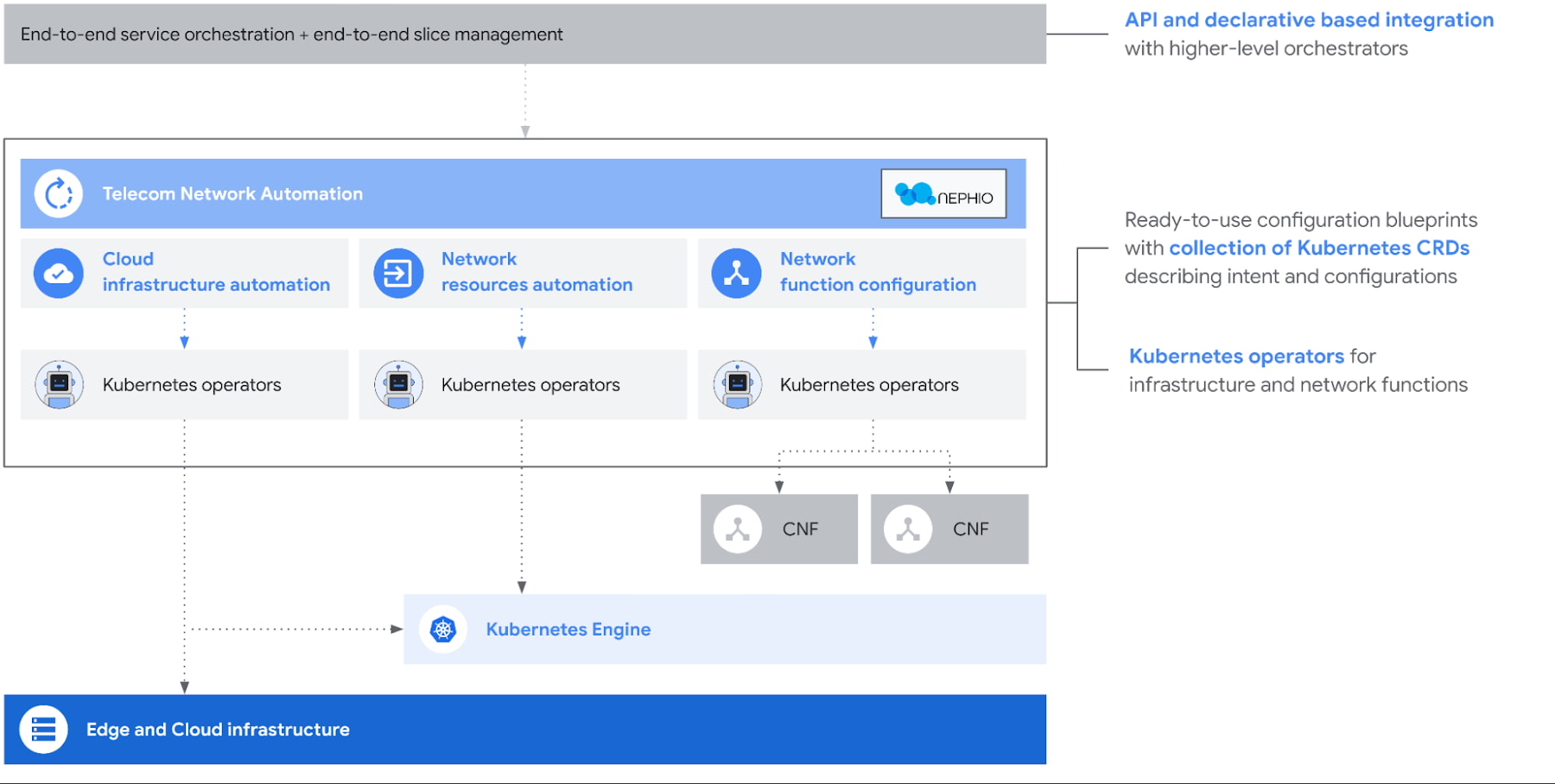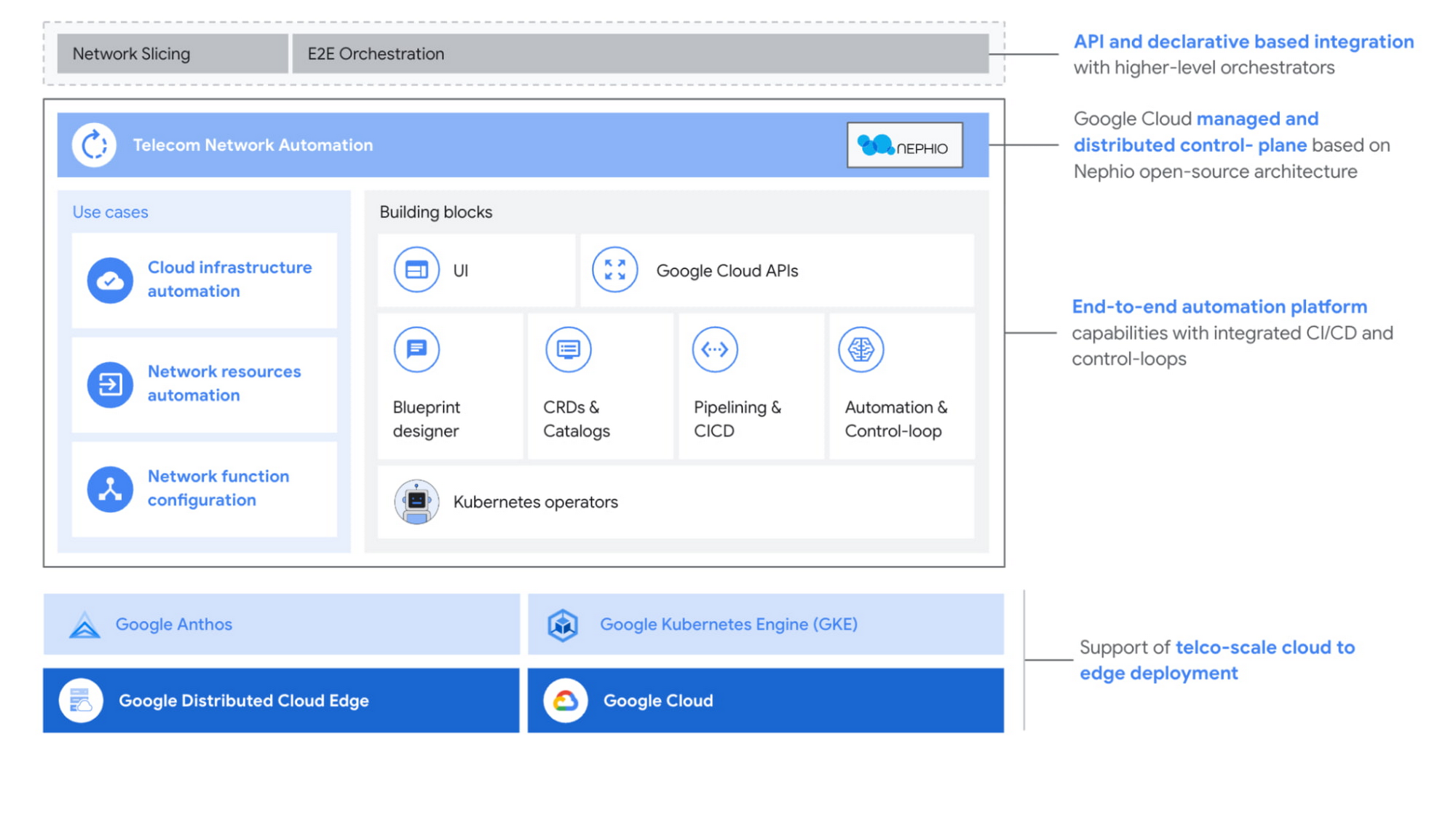Introducing Telecom Network Automation: Unlock 5G cloud-native automation with Google Cloud
Kandan Kathirvel
Group Product Manager, Google Cloud
Kaushik Bhandankar
Principal Software Engineer, Google Cloud
Try Google Cloud
Start building on Google Cloud with $300 in free credits and 20+ always free products.
Free trialBuilding and managing scalable 5G networks can be complex, especially with legacy automation approaches. Simply containerizing network functions and running them on centralized or edge clouds does not maximize the cost savings and operational efficiencies promised by the cloud.
Over the last two years, Communication Service Providers (CSPs) have approached Google Cloud looking for an open cloud-native automation solution on which to build out cloud-resilient, efficiently scalable network infrastructure that flattens their cost curve.
In response to these requests, today, at Mobile World Congress 2023 Barcelona, we announced the preview version of Telecom Network Automation, which automates the 5G deployment and management of cloud infrastructure and network functions using a simple, intent-based and declarative approach.


Telecom Network Automation is a Google-managed, cloud implementation of Nephio, a Linux Foundation open source project that can deliver simple, carrier-grade, Kubernetes-based, multi-cloud, multi-vendor, cloud-native intent automation via common automation templates.
Nephio is the latest in a long list of open source projects that Google has created and led on. Google Cloud and the Linux Foundation founded Nephio in April 2022 alongside 24 founding organizations, and the community has grown 3X since launch. We provided the seed code to the Nephio community and more contributions are planned in 1H 2023 to support Nephio’s next release.
The next era of cloud-native network automation


With Telecom Network Automation, CSPs are finally getting cloud-native network automation designed for them.
Legacy infrastructure-as-code automation systems are based on set-and-forget approaches. They can have the significant limitation of not being able to support on-demand scaling of the network, limit configuration drifts, or optimize operational costs.
Control-loop based automation systems gained traction to address these limitations. However, the traditional imperative mechanism of control-loop automation can require complex rules, triggers, and policies. Enforcement of such policies is not always guaranteed without an inherent capability to enforce a configuration.
Telecom Network Automation supports a declarative, intent-based mechanism of control-loop automation that can address the gaps of the imperative model, leveraging the strengths of Kubernetes, Nephio, and Google's years of pioneering work operating a vast global production network using these constructs.
Telecom Network Automation can enable CSPs to quickly deploy entire networks and manage them using a single pane of glass, without complexity.
At the heart of Telecom Network Automation’s architecture is the Kubernetes Resource Model and a Configuration as Data management approach that provides declarative capabilities with intent reconciliation, thus helping to guarantee that user intent matches the runtime environment. This approach collectively can deliver uniformity and consistency of lifecycle management across the cloud-native network layers — cloud infrastructure, network function deployment, and network function configuration.
Telecom Network Automation uses the standard custom resource definitions (CRDs) and pluggable Kubernetes Operators aligned with the Nephio community. Standard CRDs help alleviate vendor interoperability issues and embrace openness.
Improved service reliability and operational agility
Telecom Network Automation delivers zero-touch provisioning of cloud infrastructure and network functions, which can offer increased network availability and resiliency while reducing maintenance downtime.
It supports Day 0 (initial configuration), Day 1 (deployment), and Day 2 (continuous deployment & operations) from a single-pane user interface.
It adopts a GitOps approach that provides continuous reconciliation with simplified configuration management at scale. Telecom Network Automation leverages Kubernetes capabilities and supports configuration versioning, tagging, and additional capabilities like measuring intent drift.
It embraces the “shift left” philosophy with embedded CI/CD. It supports cross-version and vendor-specific testing, pre-submit validation of configuration, and integrates the test framework into a multi-stage release qualification pipeline, helping to prevent defects from leaking into the production environment.
It supports gradual rollouts and automated rollbacks and provides hooks for CSPs to manage rollouts on a large live network.
Collectively, these Telecom Network Automation capabilities enable CSPs in their journey to zero-touch-provisioning (ZTP), while helping to maintain their ability to exercise control of the system updates.
Towards integrated, cloud-native networks


Telecom Network Automation is part of Google Cloud telecom product portfolio and integrates with Google Distributed Cloud Edge (GDC Edge) and Google Kubernetes Engine (GKE) to help provide a unified and rich automation experience for Google Cloud customers.
Telecom Network Automation supports multi-domain automation, which can deploy network functions from multiple vendors on Google Cloud Infrastructure, as well as interface with third-party service orchestration systems for end-to-end deployments. Telecom Network Automation supports key building blocks providing turnkey automation with a catalog of ready-to-use automation blueprints, CI/CD tooling, UI and APIs for northbound integration. This holistic cloud-native automation approach can simplify and speed up the automation journey for our customers.
Further, Telecom Network Automation integrates with Telecom Data Fabric to help enable advanced control-loops and put data into action using automation. The combination of Telecom Network Automation and Telecom Data Fabric can bring the benefit of a self-managed, autonomous network, that helps to reduce operational complexity and costs. These advanced capabilities from Google Cloud can allow CSPs to enable their network fast for their customers.
Multiple CSPs are actively working with Google Cloud as design partners and early testers of Telecom Network Automation. For further details, reach out to us at Telecom_Network_Automation@google.com.



